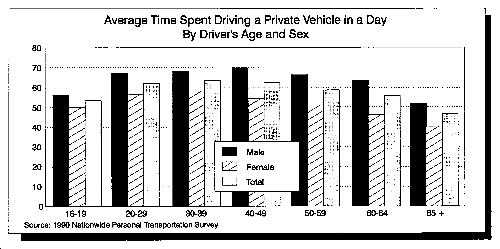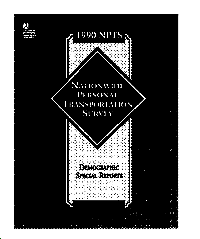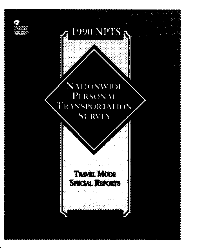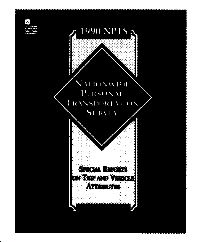 FEDERAL HIGHWAY ADMINISTRATION · OFFICE OF HIGHWAY INFORMATION MANAGEMENT
FEDERAL HIGHWAY ADMINISTRATION · OFFICE OF HIGHWAY INFORMATION MANAGEMENT
WASHINGTON, D.C. · (202) 366-0180
Time Spent Driving a Vehicle
The 1990 Nationwide Personal Transportation Survey revealed that most drivers spend an aver-age 59.7 minutes per day driving in their vehicles. The typical American spends almost 1 hour per day going to and from work, running errands, and making other trips. Men average even greater time driving at 65.4 minutes or 22 percent more time in the vehicle than did women drivers. Women driv-ers spent 53.5 minutes in their private vehicles. This gender difference is even greater among the ages of 60 years and older. The 30 to 39-year-old age group spent the largest amount of time in their automobiles (63.2 minutes), the lowest being 53.2 minutes for 16 to 19-year-old drivers.
The average time spent driving a vehicle varies by urbanized area as well. The greater the urban area size, the greater time spent driving. An urban-ized area with a population of less than 200,000 spends an average of 53.0 minutes, whereas an urbanized area of 1 million or more, with rail and subway, the average is 62.4 minutes per automobile.
For more information, contact Bryant Gross at (202) 366-5026.

Highway Trust Fund Revenues
Highway Trust Fund revenues from diesel fuel have increased significantly since the changes in the Federal diesel fuel excise tax became effective January 1, 1994. After factoring out the 4.3 cent-per-gallon motor fuel tax rate increase for deficit reduction enacted in the Omnibus Budget Recon-ciliation Act of 1993, Department of the Treasury figures show diesel fuel revenue of $3.80 billion for the first three quarters of calendar year 1994 compared to $2.75 billion for the same quarters of calendar year 1993--an increase of 38.1 per-cent. The increase appears to be primarily attribut-able to the new law requiring untaxed diesel fuel to be dyed and to the increased State and Internal Revenue Service motor fuel tax enforcement activities funded in part by the FHWA under the In-termodal Surface Transportation Efficiency Act of 1991. For further information, contact Stephen Baluch at (202) 366-9243 or Mary Moehring at (415) 744-2617.
The "Household Travel Surveys: New Concepts and Research Needs" Conference
The U.S. DOT-sponsored TRB conference, "Household Travel Surveys: New Concepts and Research Needs," was a resounding success. About 80 people participated in this conference, held March 12-15, at the Beckman Center at the Univer-sity of California, Irvine. Dr. Peter Stopher, Louisi-ana State University, chaired the conference. Gloria J. Jeff, Associate Administrator for Policy, FHWA, opened the conference, and reminded the participants that to be useful, data had to be trans-formed into information that was understandable to policymakers and decisionmakers. Dr. Stopher provided a review of household travel surveys, starting with the very large surveys conducted in the 1950's during the planning of the Interstate highway system, and concluding with current travel surveys. The participants spent the next 3 days focusing on five workshops topics:
Nonresponse: increasing non-response using telephone interviewing, response bias, identifying non-respondent charac-teristics, and imputation and weighting of responses.
Stated response: methods for using stated response to improve travel demand models, and techniques for deciding when stated response is appropriate for use in transportation surveys.
Survey methods: evaluation of different techniques such as telephone, in-home, and mail-back methods; trip, activity, or time-use recording; length of survey period; and longitudinal versus cross-sectional studies.
Data collection instruments: pretests and pilot tests of instruments, customized instruments for hard-to-reach populations, controlled experiments of instrument design.
New technologies: improvements and modifications to CATI/CAPI, GIS, GPS and multimedia for conducting household travel surveys.
The conference resulted in 24 proposed re-search projects. The proposals will be available in draft copy by June, and conference proceedings are anticipated by December 1995.
Traffic Monitoring Guide, 3rd Edition
The third edition of FHWA's Traffic Monitor-ing Guide is now available. This edition of the Traffic Monitoring Guide incorporates the metric system of measurement for the first time. In accordance with the 1988 Omnibus Trade and Competitiveness Act, which required the Federal Government to convert to the metric system, the Federal Highway Administration (FHWA) pro-duced the Metric Conversion Plan in 1991. This plan specifies that data for 1995 and thereafter shall be in metric units.
New traffic monitoring data formats were needed because of the change in weight and length measurements to metric units. This was also an op-portunity to make other changes at the same time. Accordingly, Transportation Research Board Com-mittee A2B08 on Traffic Monitoring was asked to query State traffic monitoring contacts for their ideas on what should be changed. Based on the results, a draft of new data formats was sent to the States for comment. The draft was revised, and a memorandum was distributed in February, 1994, with the new data formats. Those formats are incor-porated in this edition of the Traffic Monitoring Guide in a new Section 6, which pulls together the traffic data formats into one place.
Other changes include expanding the Station Identification field from three to six characters to conform to the format used by the #1 and #3 Records for ATR data. This allows a State to iden-tify all traffic monitoring stations in a common format. In addition, some terminology changes were also needed because the terms included units of measure. These were replaced by generic terms which don't specify the units. For example, "vehi-cle miles traveled" was replaced by "vehicle distance traveled" and "mileage" as a measure of the length of highways was replaced by "roadway extent." Unless specified otherwise, these quanti-ties are expressed in terms of vehicle kilometers and kilometers, respectively.
For more information contact Ralph Gillmann at (202) 366-5042.
National Test Center
The Office of Highway Information Manage-ment (OHIM) sponsored a feasibility study on es-tablishing a national test center for traffic monitor-ing devices, which was conducted by the Southwest Technology Development Institute at New Mexico State University. Their report ad-dresses comments received from many States and equipment vendors.
The multi-state pooled fund study S-94-3, enti-tled, National Test Center for Traffic Data Collec-tion and Monitoring Devices, was put on hold pending the completion of this study. It has recently been decided to combine this pooled-fund study with S-95-5, entitled, National Vehicle Detector Test Center. The purpose of the combined pooled-fund project is to establish and operate a user-supported national test center which would provide independent testing of commercially-available devices for traffic monitoring, surveil-lance, and control which detect vehicle presence, speed, classification, or weight.
Based on a meeting of the participating States held May 2-3, 1995, it is hoped that this pooled-fund study will become an AASHTO activity.
For more information, contact Ralph Gillmann at (202) 366-5042.
1995 Nationwide Personal Transportation Survey (NPTS) Pretest Shows Surprising Results
The unexpected result of pretesting three differ-ent approaches to colle. cting travel survey data was that the survey worked best using a travel diary. It was generally assumed that participating house-holds would prefer a method such as the memory jogger that involved very little writing, or the pure recall method that'involved no recording of trips.
There were two primary assessment measures used for the pretest evaluation, trips per household figures and response rates. The NPTS data series has usually produced trip per household that are lower than those from regional household travel surveys conducted by MPOs (metropolitan plan-ning organizations). This was the case even after the NPTS data were adjusted to be comparable to the MPO surveys by limiting the sample to urban-ized area residents, and by using only weekday trips. The diary method was included in the pretest for the 1995 NPTS to determine if trip rates would be higher through use of a diary. The pretest results demonstrates that trip rates were higher through using the travel diary. The response rates for the pretest were fairly comparable among all three methods of data collection. Thus the diary method was chosen for the main NPTS survey, which started May 1.
The pretest for the 1995 NPTS was conducted from November 1994 through January 1995. Approximately 2,500 households were interviewed nationwide. The pretest results have proved so informative that the dataset will be cleaned, edited, weighted, documented, and used for further analy-sis. At least three reports are contemplated: an analysis of the customer service questions, a brief overview of travel trends, and a full comparison of the three methods used. The last report is envi-sioned as a tool for others who are conducting household travel surveys.
For more information on the NPTS pretest, contact Carol Harbaugh at (202) 366-0076 or Susan Liss at (202) 366-5060.
1995 Nationwide Underway Personal Transportation Survey
Interviewing for the main survey of the 1995 NPTS started May 1. Approximately 25,000 house-holds will be interviewed over the course of a year for the national survey. Another 20,000 households will be interviewed for the add-on component, which consists of four areas that have purchased additional NPTS samples to obtain a household travel survey for their respective areas. The four are New York State, Massachusetts, Oklahoma City, Oklahoma and Tulsa, Oklahoma.
The 1995 survey promises to be the most com-prehensive NPTS in the data series, with the inclu-sion of odometer readings on household vehicles, greater detail on household and workplace loca-tion, information on the incidence of working at home and the incidence of occasional transit use. For more information on the 1995 NPTS, contact Carol Harbaugh (202) 366-0076 or Susan Liss, (202) 366-5060.
Nationwide Personal Transportation Survey-1990: Special Reports
Three special reports have recently been released. These reports are a series containing special-subject papers derived from the Nation-wide Personal Transportation Survey (NPTS). These volumes are designed to examine important emerging travel behavior trends, areas of public policy interest, designed to answer questions about the direction and extent of current trends, and seek to contribute to our understanding of travel phe-nomena in the United States.
These three reports can be obtained from the Federal Highway Administration, R&T Report Center, HRD-11, Room A-200, 6300 Georgetown Pike, McLean, VA 22101-2296, or FAX (703) 285-2919. Please include the report title and publication number, the quantity desired, your name, phone number, and mailing address. The reports are as follows:
Demographic Special Reports (FHWA-PL-95-032)
This report contains informa-tion on the assessment of poten-tial saturation in men's travel, travel by women, travel by the elderly, multiworker household travel demand, and household structure and travel behavior.

Travel Mode Special Reports (FHWA-PL-94-019)
This report contains informa-tion on travel by households without vehicles, recent nation-wide declines in carpooling, and use of non-motorized transportation.

Special Report on Trips and Vehicle Attributes (FHWA-PL-95-033)
This report contains information on understanding trip chain-ing, geographic factors explain-ing work trip length changes, the demography of the U.S. vehicle fleet, and time-of-day charac-teristics of travel.

Traffic Data Analysis Expert System
An expert system is a computer-based proce-dure that simulates the reasoning and decisionmak-ing of human experts. With an increasing amount of traffic data and limited staff time available, an expert system for traffic data analysis should offer several advantages:
· Routine situations could be handled automatically, freeing staff for more difficult cases.
· Consistency between data analysts should increase. Improved data quality should re-sult from better screening and editing of the data.
Expertise which takes years to acquire could be documented to better inform new staff and non-experts.
In Phase I of a recently completed project, an expert system which runs under Windows was pro-duced that assessed anomalies in traffic volume data from both permanent and portable equipment. The expertise of two veteran traffic analysts and data from 12 sites in Colorado were used in design-ing the system. This system was tested against the human experts and found to match their expertise. Overall results confirmed the expected benefits and showed a 35 percent cost savings over pre-vious methods.
Phase II of this project involved expanding the system by bringing in traffic analysts and data from two other States (Kansas and Minnesota). The set of rules that the expert system follows (called the knowledge base) was refined, and the system was modified to allow data input in stand-ard formats (FHWA card 3 format). It was also enhanced with new features including interactive editing and graphics capabilities. Copies of the software are being distributed to the State highway agencies.
For more information, contact Ralph Gillmann at (202) 366-5042.
Publications
Transportation System Performance Changes, 1980-1990:
Based on The Decennial Censuses--Research Report 1962-1
This report is based on data obtained from the 1980 and 1990 decennial censuses, and is intended to provide information regarding changes in travel time to work. Specifically, this report contains find-ings of a 3-year study of census travel time data from six of the largest urban areas in the United States. The report contains a comparison of travel time to work reported in the 1980 and 1990 census aggregated by trip orientation and mode. This report was a cooperative joint project with the Fed-eral Highway Administration, the Bureau of the Census, the American Association of State High-way and Transportation Officials, and was devel-oped through the Texas Department of Transporta-tion, and the Texas Transportation Institute. To obtain a copy of this report, contact the National Technical Information Service, 5285 Port Royal Road, Springfield, Virginia 22161.
Our Nation's Highways (FHWA-PL-95-028)
The soon to be released update of "Our Na-tion's Highways" is a condensed overview of facts and figures regarding highway condition and per-formance, the U.S. Vehicle Fleet, Motor-fuel use, travel, financing our highways, and other data of interest.
This update improves on previous editions by including more trend data, more comparisons of international data, new sections on air quality, and information on the proposed National Highway System. To obtain a copy, and/or have your name placed on the mailing list, call (202) 366-0160. If you have any questions regarding the content, please call Mary K. Teets at (202) 366-9211.
Highway Taxes and Fees
The biennial publication, "Highway Taxes and Fees, How They Are Collected and Distributed," (PL-95-036) includes information on State laws that provide for the taxation of motor fuel, motor vehicles, motor carriers, and licensed drivers, and the distribution of these taxes and fees. The 1995 edition of this publication is expected to be avail-able for distribution by July 1. For more informa-tion, contact Janet Tierney at (202) 366-5021.
Highway Statistics Questionnaire
"Highway Statistics" is an annual report devel-oped by the Office of Highway Information Man-agement that presents tables of data prepared by each State. A questionnaire on this annual report was sent to all of its users to ascertain whether this publication is meeting their needs. We were pleased with the enthusiasm shown regarding this statistical publication and are making every effort to implement those suggestions to make an even better report.
The report "Summary of Highway Statistics Customer Services Questionnaire" (PL-95-035) is available by calling the Office of Highway Infor-mation Management at (202) 366-0160. If you have any questions regarding the report, please call Mary K. Teets at (202) 366-9211.
Toll Facilities in the United States
The "Toll Facilities in the United States, Bridges-Roads-Tunnels-Ferries" (PL-95-034) has recently been released. This report provides se-lected information on toll facilities throughout the United States that are open to the public or are under construction. This biennial publication reflects the status of tolls throughout the country. It in-cludes some financial data for publicly owned toll facilities. For more information on this report, con-tact Connie M. Bell at (202) 366-5068.
Upcoming Conferences/Meetings
Highway Statistics Steering Committee
Where: Arlington, Virginia, Renaissance Hotel
When: June 21-22, 1995
Subject: The Highway Statistics Steering Committee will be meeting to discuss issues related to data collection and use. The Steering Committee participants include State, FHWA, and selected others involved or having an interest in collection and use of highway statistical data.
"Highway Performance Monitoring System (HPMS) Steering Committtee"
Where: Arlington, Virginia, Renaissance Hotel
When: June 28-29, 1995
Subject: The HPMS Steering Committee will be meeting to discuss data collection efforts. The Steering Committee participants include State, FHWA, EPA, and selected others involved or have an interest in the HPMS data collection efforts.
"Highway Information Seminar"
Where: Holiday Inn, Washington, DC
When: November 14-16, 1995
Subject: This three day Seminar will include lectures and workshops on State and local Highway Finance, Highway Performance Monitoring System data collection, traffic volume trends, policy implications of data collection efforts, and other topical areas. Guest speakers will present policy implications of data collection and developments in transportation technologies. Group sessions on each area of data collection will be provided. For more information, contact Connie M. Bell, HPM-20, at (202) 366-5068.
"National Traffic Data Acquisition Conference"
Where: Albuquerque, New Mexico
When: May 1996
Subject: The conference will cover the collection and analysis of traffic volume, vehicle classification, and truck weight data. For further information, contact Ralph Gillman at (202) 366-5042.
Back to Reports





